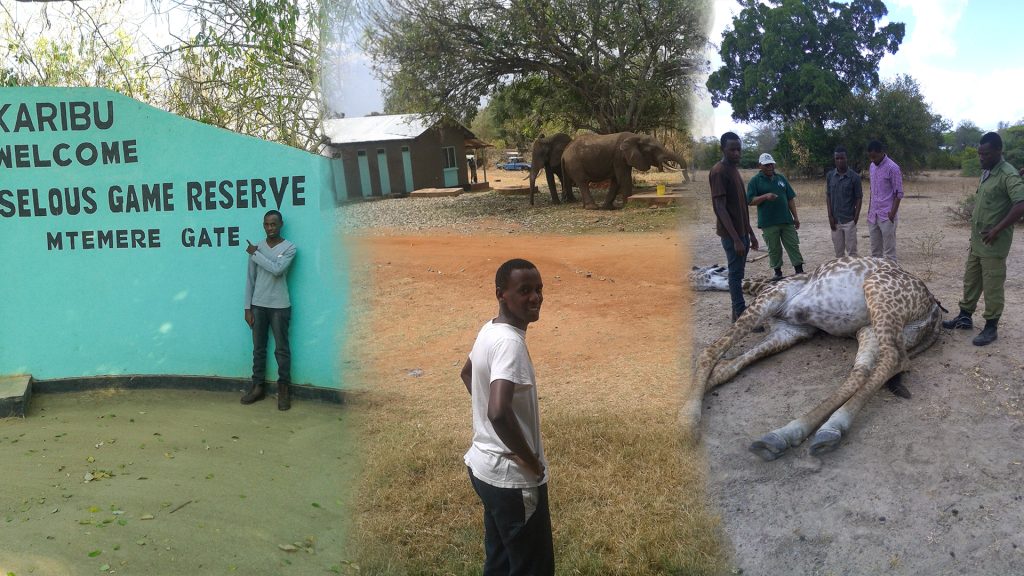It is around 2 am, and the only sound that breaks the silence is the chirping of crickets and the distant whooping call of hyenas outside our compound. Suddenly, the rangers awaken us, signalling the start of another anti-poaching patrol in reserve. This routine was familiar to us, as we had undertaken it several times during our two-month stay in the Selous Game Reserve, the largest game reserve in Africa. Let me share the captivating story of my unforgettable experience in this outstanding wilderness.
As I was a part of The Sokoine University of Agriculture, students embarked on a remarkable journey as part of our Field Practical Training program. Our destination was the famous Selous Game Reserve, where we spent two months engaging in various protection, conservation, and management activities.
Selous Game Reserve is located in the southern part of Tanzania. Before being divided to create the new Nyerere National Park, it covered over 50,000 square kilometres, encompassing parts of four Tanzanian regions: Morogoro, Pwani, Ruvuma and Lindi. The reserve’s massive area surpassed the territories of Belgium and Costa Rica. However, following the establishment of Nyerere National Park, Selous Game Reserve now occupies an area of over 20,000 square kilometres, still maintaining its status as a significant conservation area.
History
The Selous Game Reserve was first designated as an area for conservation in 1896 by the German colonial government, and later on, in 1905, it was made a hunting reserve. The reserve was named after an explorer and a big game hunter, Captain Frederick Courteney Selous, who served in the British Army. Captain Selous died in 1917 at Beho Beho (An area within the reserve) while fighting the Germans during World War I.
1982, the Selous Game Reserve was designated as a UNESCO World Heritage Site due to its biodiversity and ecological significance. In 2019, the area was divided to establish Nyerere National Park, Tanzania’s largest national park. Selous Game Reserve remains a UNESCO World Heritage Site, recognized for its remarkable biodiversity and ecological importance.
Read related: REGROW: The Tourism Link Propelling Tanzania’s Southern Circuit to New Heights.
The First Experience
I still remember my first day in the reserve as if it had happened yesterday. On a sunny Saturday, we reached Matambwe in Morogoro Rural District, where the reserve’s headquarters were. To our surprise, the reserve warden informed us that we needed to venture into the heart of the reserve with armed rangers to assist them in combating an uncontrollable wildfire. Without hesitation, we joined the rangers and successfully extinguished the wild flames together. It was an unexpected beginning to our Field Practical Training, but after all, it proved to be an incredible experience.
During my two-month stay in Selous, I was privileged to immerse myself in a beautiful and unforgettable experience. The reserve offered me an outstanding opportunity to get intimately acquainted with wildlife, an encounter unlike any I had ever experienced before. Initially, we resided at Matambwe, using the reserve’s comfortable hostels. It seemed like every other day; we were treated to the sight of majestic elephants, imposing buffalos, graceful impalas, sturdy warthogs, and a multitude of vibrant bird species that were a constant presence in our surroundings.
After a week, we relocated to Mtemere in the Rufiji District of the Coastal Region, and there, our experience reached new heights. Mtemere served as the primary entrance for tourists and housed the reserve’s airstrip, making it a bustling area.
Responsibilities
During our stay at Mtemere, our primary duties involved conducting anti-poaching patrols and guiding tourists on walking safaris, game drives and boating safaris. We were also responsible for registering tourists for several activities like walking safaris, game drives and boating safaris, and keeping records of aircraft landing at the Mtemere airstrip.
Happy Days
The definition of “good days” varies depending on one’s perspective. I consider the days to be good when we successfully fulfilled our responsibilities and closely encountered wild animals and birds. The most unforgettable moments were when I had the opportunity to guide tourists on walking safaris, game drives, and boating safaris. Interacting with tourists from around the world was an enriching experience.
I must not forget the daily encounters with wildlife, as our staff quarters were surrounded by bushes and scattered trees, attracting animals to wander nearby. During the day, diurnal animals such as monkeys, baboons, giraffes, impalas, elephant shrews, squirrels and various bird species were easily spotted. At night, animals like bush babies, servals and occasionally elephants could be seen, while the sounds of hyenas and hippos were frequently heard.
Sad Days
We all experience tough days at times, and I also had a few during my stay in Selous Game Reserve. Whenever I missed the chance to accompany tourists on walking safaris, game drives or boating safaris, it wasn’t enjoyable because those were valuable opportunities to learn more about wildlife from experienced guides. Additionally, there was a particular day when we came across the lifeless body of a female giraffe near the Mtemere airstrip, which is a popular area for walking safaris.
The giraffe seemed to have died naturally, possibly due to a disease. Witnessing the gentle and majestic tallest mammal lying on the ground was sad. Over the following day, scavengers such as vultures, marabou storks, hyenas and jackals completely consumed its remains.
Scary Nights
Living in the heart of the reserve is already quite scary, let alone conducting anti-poaching patrols during the nighttime and encountering wild animals at close range. The days we conducted these patrols were extremely scary due to the timing involved. We would wake up in the middle of the night, usually around 2 am, join armed rangers, and then drive off to the most vulnerable areas of the reserve in search of poachers.
As trainees, we would carry machetes and the rangers, armed riffles for self-defence against wild animals and poachers. I was still getting used to the challenging schedule of anti-poaching work. While the cover of darkness helped conceal poachers’ activities, it also meant venturing into the reserve when its deadliest predators were on the prowl. The rangers sat alert, gripping their rifles, a necessary precaution against encountering wildlife and potentially hostile poachers.
As the truck rolled to a stopping point in a small clearing, I took a deep breath and grabbed my machete. The head ranger gestured into the impenetrable blackness, and he would say, “Here is as far as we go. From now on, we walk” So we would start walking through the black wall of leaves. With each crunch of leaves and twigs underfoot, my pulse accelerated.
What predators had heard my approach through this quiet domain of night? A misstep could bring me face to face with one of Selous’s great predators, driven to hunt under cover of darkness. But as the hours passed with no contact, my nerves relaxed.
The rangers moved with confident, careful steps, clearly experienced in navigating this nocturnal domain. By the pale light of dawn, we emerged from the bush, exhausted but unharmed. Another successful patrol was completed without any incident. As the glowing sunshine illuminated the sweeping plains, I felt great pride in my work; the reserve’s vulnerable wildlife stood a better chance through nights like this. Back at the staff quarters, we would eat a hearty breakfast, reflecting on the trials of anti-poaching duties.
Although venturing into the reserve’s volatile heart at its most dangerous hour put us, trainees, through upsetting tests of courage, not one patrol under our team’s watch had ended poorly. We had faced terrors of Selous nights and came through unharmed, gaining vital experience in the process.
The End
After spending one and a half months in Mtemere within Selous Game Reserve, the time came for us to bid our farewell. We departed from Mtemere and returned to Matambwe, where we spent another week before finally returning to the University. During our time in Selous, we had been filled with remarkable experiences, from conducting anti-poaching patrols to encountering wildlife up close.
As we left, we carried cherished memories and a deeper understanding of the importance of conservation efforts. Selous Game Reserve had left a permanent mark on our journey, and we departed with a newfound appreciation for the beauty and diversity of the natural world.


